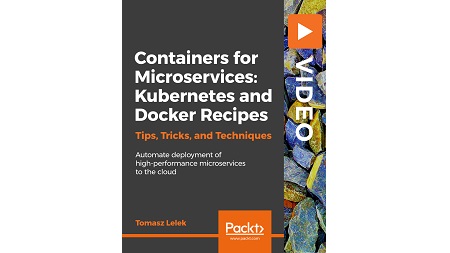
English | MP4 | AVC 1920×1080 | AAC 48KHz 2ch | 2 Hours | 475 MB
Troubleshoot and deploy microservices in the cloud
Docker is popularly used to build, ship, and run containers, and Kubernetes is used to orchestrate Docker containers. Instead of being rival technologies, Docker and Kubernetes complement each other through every stage of deployment. The best way of running a microservice app architecture is via containers as they are lightweight runtime environments and can be run on physical or virtual machines.
If you already have some experience working with Kubernetes and Docker, this course is a perfect guide with recipes that are proven to work with microservice containers using Kubernetes and Docker. Each video supplies a recipe containing a tip, trick, and technique to help you work more effectively and synergistically with Kubernetes and Docker to build, ship, run, and manage containers for your applications.
You will implement tips to help you select a microservice architecture that is appropriate for your application and business, and explore best practices to follow when building and deploying microservices for your apps throughout the workflow. You will use Docker to package and ship your apps and Kubernetes to deploy, manage, and scale them. Optionally, you can also implement best practices when deploying apps to the cloud (AWS) and multi-container microservices. You will improve performance and security in containers and microservices (and facilitate smooth communication within them), ensuring there is no data loss. You will master troubleshooting techniques to help diagnose and debug issues relating to operations, networking, and storage; you will also learn to avoid these to ensure your workflow is efficient.
By the end of the course, you will be confident to efficiently build and deploy containers for microservices using Docker and Kubernetes.
Learn
- Create secure Docker images to ship your apps
- Avoid operational anti-patterns with Kubernetes and Docker tweaks
- Leverage a Docker Enterprise Edition Hub to share your images
- Use advanced Docker commands for management and networking
- Use advanced Kubernetes commands for better security and performance
- Use and troubleshoot the Kubernetes proxy, DNS, and its networking stack
- Create secure connections between services with no data loss
- Debug and troubleshoot Kubernetes storage with advanced debugging commands
- Implement service discovery with Kubernetes’ advanced networking techniques
- Perform zero-downtime deployments of your production apps
Table of Contents
Package and Ship Your app with Docker
1 The Course Overview
2 Adding Docker Plugin into Microservices
3 Creating Maintainable Dockerfile
4 Optimizing Docker Image Size and Docker Security
5 Monitoring Docker Containers and Resources
Advanced Docker Tips and Tricks
6 Network and Data Management in Docker
7 Integrate Docker with Jenkins Build
8 Solving Docker Community Shortcomings with Docker Enterprise Edition
9 Exploring Docker Enterprise Edition Hub for Sharing Images
10 Administration Tips and Tricks with Docker
Deploying and Managing a Kubernetes Cluster for Easier Operations
11 Configure Kubernetes Server for High Performance
12 Using Kubernetes Client for Checking the Cluster Status
13 Leverage Kubernetes Proxy in Your deployment
14 Using Kubernetes DNS Component
15 Monitoring your Cluster with Kubernetes UI
Troubleshooting to Improve Performance and Security
16 Use Kubernetes Namespace to Secure Your Applications
17 Leverage Contexts to Achieve High Performance of Your Deployments
18 Manage Lifecycle of Kubernetes Objects
19 Separate Setup with Labels and Annotations
20 Troubleshoot Problems with Debug Commands
Using Pods for Monitoring and Storage
21 Defining Pod with Pod Manifest
22 Running and Monitoring Specific Pod
23 Monitoring Health of Pods with Health Checks
24 Persisting Pods Data
Creating Communication between Containers and Microservices
25 Understanding Problem of Service Discovery in Distributed Environment
26 Leveraging Service Object to Get the State of the Specific Service
27 Manual Service Discovery for More Advance Mechanism
28 Using Cluster IP Environment Variables
Creating High Performance Production Ready Deployments
29 Tweak the Kubernetes Deployment Object for Your Setup
30 Adding Security to your Deployment
31 Scaling Up and Down
32 Testing Fully Fledged, Production Ready Deployment
33 Implementing Rolling Update
Resolve the captcha to access the links!